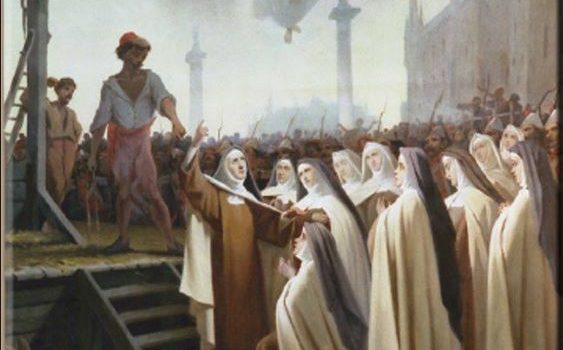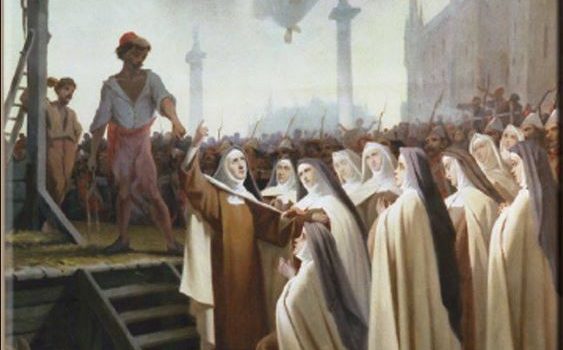If you have access to a radio station that carries the Saturday matinee broadcasts from the Metropolitan Opera, you have a memorable experience waiting for you. On January 28 the featured work will be Francis Poulenc’s Dialogues of the Carmelites (1 pm eastern time). This is a a deeply moving spiritual drama with one of the most emotionally powerful conclusions anywhere in musical theater.
The events on which Dialogues of the Carmelites is based occurred during the blood-soaked late phase of the French Revolution known as the Terror. Historian Michael Burleigh calls those terrible months “the first occasion in history when an ‘anticlerical’ and self-styled ‘non-religious’ state embarked on a program of mass murder that anticipated many twentieth-century horrors” through its largescale use of the guillotine.
Jesus told his followers to expect persecution. See, for example, John 13.18-21. And although each episode of persecution has its own peculiar traits, persecutions commonly share certain family resemblances.
As had happened earlier in England under Henry VIII and Elizabeth I, so during the French Revolution some priests and bishops became conformers while others went underground, continuing to provide Mass and sacraments for what by then had become a clandestine Church. Many of these were apprehended and killed, while others—some 25,000 to 30,000, says Burleigh —fled the country. Meanwhile, admirers of the regime took to declaring that the Revolution itself was a “political religion” with its own spcial creed and ethical code.
In 1790 the French revolutionary government had adopted a law called the Civil Constitution on the clergy which, among other things, made the common life of religious communities illegal. In August that year government agents came to the Carmelite convent in Compiegne, north of Paris, and gave the nuns a choice: give up religious life—or else. Two years later the government ordered all convents closed; regime goons seized the Compiegne Carmel and expelled the nuns.
Friends arranged for the Carmelites, now wearing civilian garb, to occupy several apartments in Paris and continue to practice community life together as best they could. After the Terror began in 1794, the authorities arrested and tried them for breaking the law. Convicted and sentenced to death, the 16 sisters, singing hymns, were hauled in an open cart through the city streets to the execution site, and there each one, after kissing a statue of the Virgin held by the prioress, went to the guillotine chanting the “Veni Creator Spiritus” and was beheaded. The Martyrs of Compiegne were beatified by Pope St. Pius X in 1906.
The opera had its origin in a novella by Gertrud von Le Fort called Song of the Scaffold and drew on a film script by the novelist Georges Bernanos. Poulenc completed it in 1955, and it had its first performance in January, 1957 (in Italian) at La Scala in Milan and later that year (in French) at the National Opera of Paris. It was first staged at the Metropolitan in 1977. Dialogues of the Carmelites is one of the relatively few operas of the past century to have to have won a place in the international opera repertory.
Undoubtedly its final scene plays a part in that. The nuns go one by one to the guillotine, singing, and as the blade drops on one, the next picks up the song. When the terrible blade comes crashing down the last time, the singing stops and the opera ends. Audiences not uncommonly sit for several moments in stunned silence before the applause begins.
✠
Image: The Blessed Carmelite Martyrs of Compiègne












